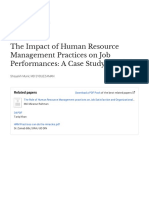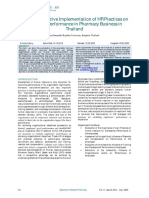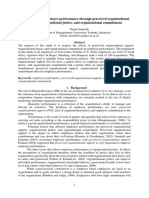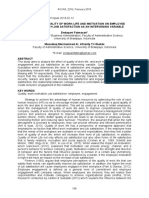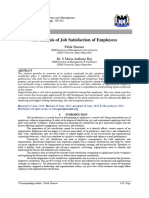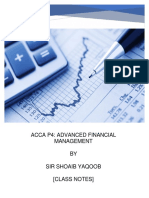SSS - Impact of Work Discipline On Employee Performance
SSS - Impact of Work Discipline On Employee Performance
Uploaded by
Gun DeathCopyright:
Available Formats
SSS - Impact of Work Discipline On Employee Performance
SSS - Impact of Work Discipline On Employee Performance
Uploaded by
Gun DeathOriginal Title
Copyright
Available Formats
Share this document
Did you find this document useful?
Is this content inappropriate?
Copyright:
Available Formats
SSS - Impact of Work Discipline On Employee Performance
SSS - Impact of Work Discipline On Employee Performance
Uploaded by
Gun DeathCopyright:
Available Formats
Impact of Work Discipline on Employee Performance Vol. 1, No.
1,
Rifa’i February 2023
Pages. 1-8
Impact of Work Discipline on Employee Performance
Asep Achmad Rifa’i1
STIE Pasim Sukabumi, West Java
Author Corresponding: achmadrifai1977@gmail.com
Abstract
This study aims to examine the effect of work discipline (WD) on employee performance (EP),
discipline factors are considered as predictors of employee performance. The design in this
study uses survey methods with descriptive and associative approaches. A total of 31
respondents were selected as samples using the non-probability sampling method, namely total
sampling/census. Data sources are primary data by disseminating instruments to selected
respondents. To test the analysis instrument of research data quality, validity and reliability
tests are used, then correlation and influence analysis, linear regression analysis, and
determination coefficient analysis are used. Research findings, it is known that WD can increase
EP. The findings showed that the level of closeness of WD with EP was 0.955, meaning that the
relationship between the two variables was at a very strong and unidirectional relationship
level, the results of calculations and analysis of the coefficient of determination (r2) showed that
WD had a positive effect on EP changes, so that the research hypothesis proposed in this study
was proven. WD has a positive effect on EP. The increase in employee performance can be
explained by Work Discipline (preventive + corrective) by 91.1%, of which 8.9% is the rest
influenced by other variables that are not studied besides the Work Discipline variable.
Keywords: employee performance; work discipline
Pendahuluan
Human resource management handles various matters related to human resources or workers
working within the company in order to achieve the targets set by the company. Companies in
achieving their goals and competing in this era of globalization require competent and quality
human resources obtained from good human resource management. Human resource
management includes job analysis, planning, recruitment, selection, training, development,
performance appraisal, compensation, safety and health of human resources. These aspects of
human resource management are very closely related and require careful and good application.
Planning provides criteria that must be met by managers to achieve predetermined goals.
While supervision is used with the aim of being able to monitor deviations from the plan caused
by events beyond the control of management. In existing practice, reliable human resources,
morale, work experience are constituted, and increased work discipline, factors that need and
are important to consider in an effort to achieve good performance. Discipline is an attitude,
behavior, and action that is in accordance with company regulations both written and
unwritten. According to Hasibuan (2017:21), discipline is the sixth operative function of Human
Resource Management. Discipline and discipline are the most important operative functions of
HR because the better the discipline of employees, the higher the possibility of employee work
performance that can be achieved. Without good employee discipline, it is difficult for corporate
organizations to achieve optimal results.
ISSN-E: XXXX-XXXX 1 https://ip2i.org/jip/index.php/ema
Vol. 1, No. 1,
February 2023 Jurnal Ekonomi, Manajemen dan Akuntansi
Pages. 1-8
Disiplin merupakan salah satu faktor penentu tercapainya target yang harus dipenuhi,
oleh Therefore, increasing work discipline is a factor that needs to be considered in an effort to
improve the performance of employees. Efforts to improve performance for employees are not
easy because they involve mental attitudes, changes in behavior, work discipline and expertise.
According to Hasibuan (2016:64), Stating that expertise should receive primary attention to
selection qualifications, this will determine whether or not a person is able to complete the
work assigned to him. The quality of work can be seen from the work process and work
discipline as well as the work output achieved by an employee in accordance with company
provisions and in accordance with the expectations of stakeholders. In line with the statement
Byars & Rue in Sutrisno (2016:74), states that employee performance as a result of work in
quality and quantity achieved by an employee in carrying out his duties in accordance with the
responsibilities given to him.
This study aims to determine the improvement of employee performance in terms of
work discipline which emphasizes the application of indiscipline enforced through preventive
and corrective actions. The research was conducted at company X in Sukabumi. To fulfill the
objectives of this study, the research stage is carried out by describing the literature review,
research methods, research results and findings, ending with conclusions.
Literature Review
Management Theory
According to Appley & Lee (2010:16), Management is an art and science, in management there
is a strategy of utilizing the energy and minds of others to carry out an activity directed at
achieving predetermined goals. While according to Terry (2012:13), states that management is
a distinctive process consisting of planning, organizing, mobilizing, and controlling actions to
determine and achieve goals through the use of human and other resources.
The research synthesis that management is a process, art and science to carry out an
activity consisting of actions in the form of planning, organizing, mobilizing and controlling to
achieve certain goals.
Human Resource Management
Humans always have an increasingly important position in an ever-evolving society. Even if we
are different or heading into a work-oriented society, it does not mean to ignore the people who
carry out the work. The views or philosophies held by the community show this with the
increasingly strong demand to pay attention to human aspects and not just technological and
economic aspects in every business.
According to Yoder in Hasibuan (2016:21), Management is the provision of leadership and
direction of people in their working or employment relationship. Human resource management
is concerned with human management through organizational activities and operational
functions. The person who carries out these activities is human resource management, which
obtains authority from the general manager to manage people in an organization.
Work Discipline
Liou & Liang (2021), stated that discipline is a rule applied by management to lead, direct and
guide organizational personnel in an effort to achieve the desires that the organization aspires
to today and in the future.
According to Hasibuan (2017:21), discipline is the sixth operative function of Human
Resource Management. Discipline and discipline are the most important operative functions of
https://ip2i.org/jip/index.php/ema 2 ISSN-E: XXXX-XXXX
Impact of Work Discipline on Employee Performance Vol. 1, No. 1,
Rifa’i February 2023
Pages. 1-8
HR because the better the discipline of employees, the higher the possibility of employee work
performance that can be achieved. Without good employee discipline, it is difficult for a
corporate organization to achieve optimal results. Work discipline is divided into two types of
work discipline, namely: (1) Preventive work discipline; and (2) Corrective work discipline.
Employee Performance
Effective quality improvement has become a potentially valuable way to secure competitive
advantage and improve organizational performance (Lakhal, 2009). According to Antony &
Bhattacharyya (2010), states that organizational performance is defined as a measure of how
well the organization is managed and the value they provide to customers and other
stakeholders..
According to Sinambela (2019:481), employee performance is the result of work that can
be achieved by a person or group of people in an organization, in accordance with their
respective authorities and responsibilities, in order to achieve the goals of the organization
concerned legally, not violating the law and in accordance with morals and ethics (Firmansyah
et al., 2021). There are four categories that can be used to measure the level of individual
employee performance:
1. Quality
2. Quantity
3. Job knowledge
4. Availabilty
It is realized that many variables are significantly related to employee performance and as
the main contributors, including motivation, work discipline and employee work experience
(Sinambela, 2019:331). If employees have ignored work discipline, it can be ascertained that
performance will decrease so that it is no longer said to be the maximum work achievement
they produce, and vice versa. Following Cole (2008), that discipline reinforces employee
disciplinary action to stimulate the growth of motivation that can encourage employees to
remain at their best performance every time they carry out and complete work that is their duty
and responsibility.
H1 : Work discipline affects the improvement of employee performance
Methodology
The method used is a descriptive and verifiative method with a quantitative approach. Referring
to Sugiyono's statement (2015:7); Sugiyono (2017:13) about research methods that can be done
by a researcher in order to meet scientific rules in research.
The research sample was 31 people, selected using non-probability sampling techniques
(Sugiyono, 2019:129), with purposive sampling, sampling criteria were considered (Sharma,
2017; Sample units and phenomena that occur in organizations are selectively and subjectively
considered worthy of study related to the characteristics and behavior of the people in them
(Hibberts et al., 2012; Sharma, 2017), this is a consideration referring to the purpose of this
study. Data collection techniques are carried out by observation, interviews and distribution of
instrument deployments. The source of the data used is primary data obtained from
respondents' dates, processed using the help of the SPSS v26 program. Validity and reliability
tests are performed as data quality tests, and for statistical analysis linear regression analysis is
used using the following equations:
ISSN-E: XXXX-XXXX 3 https://ip2i.org/jip/index.php/ema
Vol. 1, No. 1,
February 2023 Jurnal Ekonomi, Manajemen dan Akuntansi
Pages. 1-8
a+bx=y … [1]
In addition, analysis of the coefficient of determination (r2) is also used. The formula for
the coefficient of determination in this study is :
KD = r2 x 100% … [2]
Where:
KD = Coefficient of determination
r = Correlation coefficient
Measurement:
Work Discipline (WD) :X = 7WD
Employee Performance (EP) :Y = 10 EP
Results and Discussion
Based on the results of instrument testing, it shows that the data collected is declared valid and
reliable, so that the data is suitable for statistical analysis to answer questions and hypotheses in
this study.
Descriptive Analysis of Work Discipline
Work discipline (WD) problems can be described descriptively using seven indicators:
Table 1. Description of Work Discipline Statistics Based on Respondents' Responses
No Indicator Descriptive Work Discipline Variables
1 SOP (WD1) Respondents agreed 71.0%, and strongly agreed 29.0%.
Respondents expressed doubt as much as 12.9%, agreed as
2 Attendance (W2)
much as 54.8%, and strongly agreed 32.3%.
Respondents expressed doubt as much as 19.1%, agreed as
3 Delay (WD3)
much as 61.3%, and strongly agreed 35.5%.
An error occurred Respondents expressed hesitation as much as 6.5%, agreed
4
(WD4) as much as 64.5%, and strongly agreed 29.0%.
Respondents expressed doubt as much as 3.2%, agreed as
5 Penalty (WD5)
much as 67.7%, and strongly agreed 29.0%.
Respondents agreed with 51.6%, and strongly agreed with
6 Punishment (WD6)
48.4%.
Respondents disagreed 3.2%, agreed 45.2%, and strongly
7 PHK (WD7)
agreed 51.6%.
Source: Researchers' calculation results (2023)
Univariately, it can be seen that Work Discipline (WD1-WD7) according to 31 respondents
can be enforced through the seven indicators of work discipline.
Descriptive Analysis of Employee Performance
Employee performance problems (EP) can be described descriptively using ten indicators:
Table 2. Description of employee performance statistics based on respondents' responses
No Indikator Descriptive Employee Performance Variables
1 Employee capabilities Respondents agreed 71.0%, and strongly agreed 29.0%.
https://ip2i.org/jip/index.php/ema 4 ISSN-E: XXXX-XXXX
Impact of Work Discipline on Employee Performance Vol. 1, No. 1,
Rifa’i February 2023
Pages. 1-8
(EP1)
2 Quality standards Respondents expressed hesitation as much as 3.2%, agreed as
(EP2) much as 71.0%, and strongly agreed 25.8%.
3 Result (EP3) Respondents expressed doubt by 3.2%. Respondents who said
agreed as much as 64.5%, and strongly agreed 32.3%.
4 Sum (EP4) Respondents expressed doubt by 3.2%. Respondents who
expressed agreement as much as 67.7%, and strongly agreed
29.0%
5 Established standards Respondents agreed with 51.6%, and strongly agreed with
(EP5) 48.4%.
6 Job understanding Respondents strongly disagreed with 3.2%. Respondents who
(EP6) said they agreed as much as 45.2%, and strongly agreed as much
as 51.6%.
7 Job completion skills Respondents strongly disagreed with 3.2%. Respondents who
(EP7) said they agreed as much as 64.5%, and strongly agreed as much
as 32.2%.
8 Time provided (EP8) Respondents strongly disagreed with 3.2%. Respondents who
expressed approval as much as 87.1%, and strongly agreed as
much as 9.7%.
9 Completed on time Respondents strongly disagreed with 3.2%. Respondents who
(EP9) said they agreed as much as 67.7%, and strongly agreed as much
as 29.0%.
10 Time maximization Respondents strongly disagreed with 3.2%. Respondents who
(EP10) said they agreed as much as 64.5%, and strongly agreed as much
as 32.3%.
Source: Researchers' calculation results (2023)
Whether or not Employee Performance (EP1-EP10) according to 31 respondents can be
caused by the state of 10 (ten) indicators of employee performance.
Correlation Analysis
To determine the level of closeness between Employee Performance (EP_Y) and Work Discipline
(WD_X), the correlation analysis method is used.
Table 3. Pearson Correlation Analysis
Employee
Work Discipline
Performance
Employee
Pearson Correlation 1 .955**
Performance
Sig. (2-tailed) .000
N 31 31
Source: Researchers' calculation results (2023)
It is known that the correlation value of the level of closeness of employee performance
variables with work discipline variables is 0.486 and is marked positively, the correlation value
is between 0.800 – 0.100, which means that it has criteria for a very strong and unidirectional
level of closeness or relationship. The nature of positive relationships which means that if Work
Discipline has improved, Employee Performance will also increase. Vice versa, if Work
Discipline decreases, Employee Performance will also decrease. This shows that work discipline
has a very strong and unidirectional correlation or level of closeness.
ISSN-E: XXXX-XXXX 5 https://ip2i.org/jip/index.php/ema
Vol. 1, No. 1,
February 2023 Jurnal Ekonomi, Manajemen dan Akuntansi
Pages. 1-8
Coefficient of Determination Analysis
To find out the amount of improvement in employee performance explained by the amount of
work discipline value, it can be known from the results of the coefficient of determination
analysis.
Table 4. Model Summaryb
Model R R2 Adj. R2 Std. Error of the Estimate
1 .955a .911 .908 1.860
a. Predictors: (Constant), Work Discipline
Source: Researchers' calculation results (2023)
The table above, shows that the magnitude of the coefficient of determination seen from
the value of r2 is 0.911 or 91.1%. This means that Work Discipline is able to explain Employee
Performance by 91.1%, has another meaning Work Discipline contributes 91.1% influence on
Employee Performance, and the remaining 8.9% is influenced by other variables that are not
studied other than the Work Discipline variable.
Regression Analysis
The occurrence of changes in employee performance either up or down can be seen from the
direction of change in work discipline. This prediction is shown by the Coefficeinta table.
Table 5. Coefficientsa
Unstandardized Standardized
Coefficients Coefficients
Model B Std. Error Beta t Sig.
1 (Constant) 6.419 1.370 4.685 .000
Work
1.478 .086 .955 17.261 .000
Discipline
a. Dependent Variable: Employee Performance
Source: Researchers' calculation results (2023)
Then the equation is:
6,419 + 1,478 x = y
From the regression equation, it can be translated that Constant (a) has a value of 6.478,
stating that if the Work Discipline variable (X) does not increase or is constant as it is today, then
the value of the Employee Performance variable (Y) is 6.419. The directional value of the
regression coefficient (b) of the Work Discipline variable (X) is 1.478 and has a positive sign,
meaning that if work discipline positively increases by 1X, then the data increases performance
by 1.478X, and vice versa. This shows that Work Discipline has a unidirectional relationship
with Employee Performance.
Discussion
Based on the results of the correlation analysis, it shows that Work Discipline has a relationship
with a very strong level of closeness with Employee Performance. The results of a simple linear
regression analysis, it is known that the direction of the coefficient of value b for Work
Discipline as an independent variable of 1.478, means that Work Discipline can be predicted to
be able to influence the decline or increase in employee performance in accordance with the
decrease or increase in Work Discipline. The value of r2 close to the value of +1 indicates that
https://ip2i.org/jip/index.php/ema 6 ISSN-E: XXXX-XXXX
Impact of Work Discipline on Employee Performance Vol. 1, No. 1,
Rifa’i February 2023
Pages. 1-8
the ability of Work Discipline in explaining and checking Employee Performance is very large.
The magnitude of the contribution of the influence of Work Discipline explained through
preventive discipline and corrective discipline to every change in Employee Performance was
0.911 or 91.1%, while the remaining 8.9% was influenced by other independent variables that
were not studied other than the Work Discipline variable. These results are in line with the
results of the study J. S. Hasibuan & Silvya (2019), which shows the finding that It is partially
known that work discipline has a positive and significant influence on employee performance.
Work discipline is indeed needed to maintain efficiency and support the smooth running
of all company activities so that they can run well sustainably. This shows that the enforcement
of discipline to employees can contribute to the smooth running of company activities so that
they can achieve superior and reliable best performance for the progress of the company.
Therefore, work discipline is the key to the success of an employee to be able to work better
than the company's expectations in achieving its long-term goals in a sustainable manner.
Employee performance increases when strict disciplinary measures are applied, awareness of
work discipline as an effect of discipline enforcement has the potential to improve employee
performance.
Conclusions
Descriptively it can be explained that work discipline and employee performance are already in
good performance. The results of linear regression analysis show that Work Discipline as an
independent variable can be predicted to be able to influence the decline or increase in
employee performance in accordance with the decrease or increase in Discipline both
preventive and corrective Work. The ability of Work Discipline in checking and influencing
Employee Performance is very large, this shows that work discipline is one of the best
predictors for improving employee performance. For further research, it is considered
necessary to add other variables that are thought to affect employee performance.
References
Appley, A. L., & Lee, O. L. (2013). Pengantar Manajemen. Salemba Empat. Jakarta.
Cole, N. (2008). Consistency in employee discipline: an empirical exploration. Personnel Review,
37(1), 109–117. https://doi.org/10.1108/00483480810839996
Firmansyah, D. (2022). Teknik Pengambilan Sampel Umum dalam Metodologi Penelitian: Literature
Review. Jurnal Ilmiah Pendidikan Holistik (JIPH), 1(2), 85–114.
https://doi.org/10.55927/jiph.v1i2.937
Firmansyah, D., Saepuloh, D., Andriani, N. Y., & Laksana, A. (2021). Penentu Kinerja Pegawai Dari
Motivasi, Beban Kerja dan Komitmen Organisasional. Jurnal Disrupsi Bisnis, 4(2), 108–117.
https://doi.org/10.32493/drb.v4i2.9026
Hasibuan, J. S., & Silvya, B. (2019). Pengaruh Disiplin Kerja dan Motivasi Terhadap Kinerja
Karyawan. Prosiding Seminar Nasional USM, 2(1), 134–147.
Hasibuan, M. S. (2016). Manajemen Sumber Daya Manusia, edisi revisi, Cetakan Kesembilan belas,
(Revisi). PT.Bumi Aksara. Jakarta.
ISSN-E: XXXX-XXXX 7 https://ip2i.org/jip/index.php/ema
Vol. 1, No. 1,
February 2023 Jurnal Ekonomi, Manajemen dan Akuntansi
Pages. 1-8
Hasibuan, M. S. P. (2017). Manajemen Sumber Daya Manusia, Edisi Revisi, Cetakan Ke-21 (Cetakan
21). Jakarta: Bumi Aksara.
Liou, D. D., & Liang, J. “Grace.” (2021). Toward a theory of sympathetic leadership: Asian American
school administrators’ expectations for justice and excellence. Educational Administration
Quarterly, 57(3), 403–436. https://doi.org/10.1177/0013161X20941915
Sharma, G. (2017). Pros and cons of different sampling techniques. International Journal of Applied
Research, 3(7), 749–752.
Sinambela, L. P. (2019). Manajemen Sumber Daya Manusia. In PT.Bumi Aksara.
Sugiyono. (2015). Metode Penelitian Komibansi (Mix Methods). Bandung: CV. Alfabeta.
Sugiyono. (2017). Metode Penelitian : Kuantitatif, Kualitatif, dan R & D. Alfabeta.
ww.cvalfabeta.com
Sutrisno, E. (2016). Manajemen Sumber Daya Manusia. Jakarta: Kencana Prenadamedia Group.
Terry, G. T. (2012). Prinsip-Prinsip Manajemen (Cet. ke 11). Bumi Aksara.
https://ip2i.org/jip/index.php/ema 8 ISSN-E: XXXX-XXXX
You might also like
- EXCERPT - Vogue Business Index Spring 2021Document15 pagesEXCERPT - Vogue Business Index Spring 2021seerat virdi50% (2)
- 34 Tongwell PLCDocument2 pages34 Tongwell PLCxichristinaNo ratings yet
- The Impact of Performance Evaluation On Workers ProductivityDocument14 pagesThe Impact of Performance Evaluation On Workers ProductivityOli Ahmed100% (1)
- Training Slides For KaizenDocument103 pagesTraining Slides For Kaizenikolev57100% (17)
- Incremental Operating Cash Flow CalculationDocument11 pagesIncremental Operating Cash Flow Calculationmehrab1807100% (1)
- 5 ScopeDocument19 pages5 ScopeFührer Magdi BadranNo ratings yet
- Template-QEMS-NURUL FADHILAHDocument7 pagesTemplate-QEMS-NURUL FADHILAHCandroTuaNababanNo ratings yet
- WD - Organizational Culture, Competency, Perfomance (Final) - 2Document11 pagesWD - Organizational Culture, Competency, Perfomance (Final) - 2PASCA/1419203007/RISKA BRNo ratings yet
- 2560-Article Text-4341-1-10-20181130Document7 pages2560-Article Text-4341-1-10-20181130Haroon KhanNo ratings yet
- Jurnal Internasional 13Document13 pagesJurnal Internasional 13Alridho PutraNo ratings yet
- Jurnal Skripsi LizaDocument6 pagesJurnal Skripsi Liza64191166 SITI NURHALIZAHNo ratings yet
- Impact of Job Satisfaction On Employee Performance A Study With Reference To Biblical Management PrinciplesDocument14 pagesImpact of Job Satisfaction On Employee Performance A Study With Reference To Biblical Management PrinciplesRidwan ibnuNo ratings yet
- The Effect OfLeadership Style ToJob Satisf Action, Employee Engagement AndEmployee Perf Ormance (Study at PT. Interbat, Bali, Nusra, and Ambon)Document9 pagesThe Effect OfLeadership Style ToJob Satisf Action, Employee Engagement AndEmployee Perf Ormance (Study at PT. Interbat, Bali, Nusra, and Ambon)Sephia -No ratings yet
- Impact of HR Dimensions On Org PerformanceDocument9 pagesImpact of HR Dimensions On Org PerformanceXahra MirNo ratings yet
- Employee Engagement and PerformanceDocument3 pagesEmployee Engagement and PerformanceBirat AcharyaNo ratings yet
- Review of Literature: Effect of Performance Appraisal On Employee PerformanceDocument8 pagesReview of Literature: Effect of Performance Appraisal On Employee PerformanceAnand ThomasNo ratings yet
- Research Paper Open AccessDocument6 pagesResearch Paper Open AccessAJHSSR JournalNo ratings yet
- Influence of Professionality Servant LeaDocument8 pagesInfluence of Professionality Servant LeaNova KartikaNo ratings yet
- Abdul RohmanDocument7 pagesAbdul RohmanalamtareqNo ratings yet
- Admin, 1.1 - Comparitive Study of Banking Industry - Hafiz FawadDocument11 pagesAdmin, 1.1 - Comparitive Study of Banking Industry - Hafiz FawadAmna JavedNo ratings yet
- SSRN Id3645036Document18 pagesSSRN Id3645036elmar comonalNo ratings yet
- Employee Performance at PT. Artefak Arkindo As Affected by Leadership, Work Motivation and Job SatisfactionDocument6 pagesEmployee Performance at PT. Artefak Arkindo As Affected by Leadership, Work Motivation and Job SatisfactionInternational Journal of Innovative Science and Research TechnologyNo ratings yet
- Ecotal V1i1 3Document12 pagesEcotal V1i1 3Riski AlfalahNo ratings yet
- The Impact of Human Resource Management Practices On Job Performances: A Case Study of DhakaDocument11 pagesThe Impact of Human Resource Management Practices On Job Performances: A Case Study of DhakaJunaidNo ratings yet
- The Impact of Job Discipline TDocument12 pagesThe Impact of Job Discipline TRirin MeyyNo ratings yet
- Titta Gusni Salim1, CSP Wekadigunawan2, Weka - Digunawan@esaunggul - Ac.idDocument9 pagesTitta Gusni Salim1, CSP Wekadigunawan2, Weka - Digunawan@esaunggul - Ac.idGIZI RSUD TAMANSARINo ratings yet
- Evaluating Motivational Factors and Its Impact On Employee Performance in Nepalese Commercial BankDocument82 pagesEvaluating Motivational Factors and Its Impact On Employee Performance in Nepalese Commercial BankAmrit ShresthaNo ratings yet
- Heliyon: Mohamed Mahmoud Khtatbeh, Anuar Shah Bali Mahomed, Suhaimi Bin Ab Rahman, Rosmah MohamedDocument9 pagesHeliyon: Mohamed Mahmoud Khtatbeh, Anuar Shah Bali Mahomed, Suhaimi Bin Ab Rahman, Rosmah MohamedRobinson GarciaNo ratings yet
- Chapter One & Two Human Resource PlanningDocument25 pagesChapter One & Two Human Resource PlanningMentorNo ratings yet
- The Impact of Human Resource Management Practices On Employee Performance Among Manufacturing Employees in MalaysiaDocument15 pagesThe Impact of Human Resource Management Practices On Employee Performance Among Manufacturing Employees in MalaysiaIqliana AzmiNo ratings yet
- IJEMA Volume 1 No.1 (2023)Document10 pagesIJEMA Volume 1 No.1 (2023)CV. Lafadz JayaNo ratings yet
- The Effect of Work Discipline and Work Motivation On Job Satisfaction and Its Impact On The Performance of Government EmployeesDocument10 pagesThe Effect of Work Discipline and Work Motivation On Job Satisfaction and Its Impact On The Performance of Government EmployeesaijbmNo ratings yet
- Impact of Effective Implementation of HR Practices On Employee Performance in Pharmacy Business in ThailandDocument10 pagesImpact of Effective Implementation of HR Practices On Employee Performance in Pharmacy Business in ThailandM Fzn LbsNo ratings yet
- ''Performance Appraisal System and Employee Satisfaction: The Role of Trust Towards Supervisors''Document14 pages''Performance Appraisal System and Employee Satisfaction: The Role of Trust Towards Supervisors''Prateek Bhatia0% (1)
- HR Training and Actual Performance in Hotel IndustryDocument56 pagesHR Training and Actual Performance in Hotel IndustryAdnan Yusufzai80% (5)
- Improving EmployeDocument9 pagesImproving EmployeDandy RamadanNo ratings yet
- 9 Effect of Organization Commitment, Work Motivation, and Work Discipline On Employee Performance (Case Study Pt. PLN (Persero) P3B Sumatera Upt Padang)Document12 pages9 Effect of Organization Commitment, Work Motivation, and Work Discipline On Employee Performance (Case Study Pt. PLN (Persero) P3B Sumatera Upt Padang)Gun DeathNo ratings yet
- The Impact of Job Satisfaction, Job Attitude and Equity On Employee PerformanceDocument7 pagesThe Impact of Job Satisfaction, Job Attitude and Equity On Employee PerformanceRifqa SatwikaNo ratings yet
- Review of LiteratureDocument26 pagesReview of LiteraturelogeshwariNo ratings yet
- The Influence of Leadership Style Work EnvironmentDocument9 pagesThe Influence of Leadership Style Work EnvironmentRio RadesaNo ratings yet
- Impact of HR Practices On Organizational Effectiveness - A Study With Reference To Engineering Colleges in Chennai Tamil NaduDocument12 pagesImpact of HR Practices On Organizational Effectiveness - A Study With Reference To Engineering Colleges in Chennai Tamil NaduDr. KANAGALURU SAI KUMARNo ratings yet
- Moderating EffectDocument19 pagesModerating EffectSu Hlaing OoNo ratings yet
- The Impact of Human Resource Practices On Employee Perceived Performance in Pharmaceutical Sector of PakistanDocument7 pagesThe Impact of Human Resource Practices On Employee Perceived Performance in Pharmaceutical Sector of PakistanArmanlover ArmanNo ratings yet
- Role of Human Resource Practices in Employee Performance and Job Satisfaction With Mediating Effect of Employee EngagementDocument17 pagesRole of Human Resource Practices in Employee Performance and Job Satisfaction With Mediating Effect of Employee EngagementDesynta Rahmawati GunawanNo ratings yet
- File BSNLDocument3 pagesFile BSNLVinay BansalNo ratings yet
- 17 May2019Document11 pages17 May2019victor ogotNo ratings yet
- Role of Performance Appraisal System andDocument14 pagesRole of Performance Appraisal System andRohan Nandgaokar100% (1)
- Structural Equation Modeling (SEM) Analysis of Organizational Commitment and Employee Performance in PT. Telekomunikasi Indonesia. TBKDocument11 pagesStructural Equation Modeling (SEM) Analysis of Organizational Commitment and Employee Performance in PT. Telekomunikasi Indonesia. TBKThe IjbmtNo ratings yet
- RolDocument9 pagesRolDamini VarpeNo ratings yet
- Impact of Training Methods On Employee Satisfaction in Commercial Banks of BangladeshDocument9 pagesImpact of Training Methods On Employee Satisfaction in Commercial Banks of BangladeshDr. Nazrul IslamNo ratings yet
- 218 1613714733Document12 pages218 1613714733Kookie ShresthaNo ratings yet
- 1105-Article Text-2423-1-10-20220213Document19 pages1105-Article Text-2423-1-10-20220213ThemanisfunNo ratings yet
- Restructuring-The-Relationship Between PM and EEDocument11 pagesRestructuring-The-Relationship Between PM and EEKhalid MemonNo ratings yet
- The Human Resources Management Strategies and Its Role in The AchievementDocument8 pagesThe Human Resources Management Strategies and Its Role in The Achievementindex PubNo ratings yet
- 22119-Article Text-69667-1-10-20190207Document12 pages22119-Article Text-69667-1-10-20190207Janlenn GepayaNo ratings yet
- ALL ISAAC'S PROJECT CorrectedDocument25 pagesALL ISAAC'S PROJECT CorrectedSamuel MosesNo ratings yet
- The Effect of Quality of Work-Life and Motivation PDFDocument7 pagesThe Effect of Quality of Work-Life and Motivation PDFJeyaar RsNo ratings yet
- 827-Article Text-1632-1-10-20210422Document12 pages827-Article Text-1632-1-10-20210422vachirawinNo ratings yet
- Yee Performance in The Organizational Context of BangladeshDocument20 pagesYee Performance in The Organizational Context of BangladeshAl Sayad ArifNo ratings yet
- Effectiveness of Performance Appraisal SDocument26 pagesEffectiveness of Performance Appraisal SmariyaNo ratings yet
- The Determinant of Work Performance and Performance of Employees Civil Servants in MedanDocument7 pagesThe Determinant of Work Performance and Performance of Employees Civil Servants in MedanaijbmNo ratings yet
- An Analysis of Job Satisfaction of Employees: Palak SharmaDocument4 pagesAn Analysis of Job Satisfaction of Employees: Palak Sharmakamaliwaran.mbaNo ratings yet
- Final Project ARMDocument19 pagesFinal Project ARMQambarNo ratings yet
- Transformational and Transactional Leadership in Mental Health and Substance Abuse OrganizationsFrom EverandTransformational and Transactional Leadership in Mental Health and Substance Abuse OrganizationsNo ratings yet
- Model Answer: Literature review on Employee motivation, rewards and performanceFrom EverandModel Answer: Literature review on Employee motivation, rewards and performanceNo ratings yet
- Answer To MTP - Intermediate - Syl2016 - June2017 - Set 1: Paper 8-Cost AccountingDocument17 pagesAnswer To MTP - Intermediate - Syl2016 - June2017 - Set 1: Paper 8-Cost AccountingMonika AggarwalNo ratings yet
- PAHS 401 Public Finance: Session 5 - Government RevenueDocument20 pagesPAHS 401 Public Finance: Session 5 - Government RevenueOFORINo ratings yet
- Apex Appraisal Service Announces Deal With Opteon To Bring Innovation and Technology To The U.S. Appraisal IndustryDocument3 pagesApex Appraisal Service Announces Deal With Opteon To Bring Innovation and Technology To The U.S. Appraisal IndustryPR.comNo ratings yet
- Sale of GoodsDocument38 pagesSale of GoodsAmir HusniNo ratings yet
- Finance Mid Term PDFDocument2 pagesFinance Mid Term PDFMD GOLAM SARWERNo ratings yet
- Liability SideDocument18 pagesLiability Sideayman FergeionNo ratings yet
- Ralatório MDADocument13 pagesRalatório MDAMiguel LoureiroNo ratings yet
- IE 001 - Case #2 - Starbucks - MacsDocument3 pagesIE 001 - Case #2 - Starbucks - MacsGab MuyulaNo ratings yet
- This Study Resource Was: Pre-QE ExaminationDocument8 pagesThis Study Resource Was: Pre-QE ExaminationMarcus MonocayNo ratings yet
- 03 Mrunal Economy Handout 2020Document43 pages03 Mrunal Economy Handout 2020Sicky SandilyaNo ratings yet
- Acca P4: Advanced Financial Management BY Sir Shoaib Yaqoob (Class Notes)Document216 pagesAcca P4: Advanced Financial Management BY Sir Shoaib Yaqoob (Class Notes)Saad QureshiNo ratings yet
- BARCLAYS - Global Credit Outlook 2016 - An Aging CycleDocument206 pagesBARCLAYS - Global Credit Outlook 2016 - An Aging CyclenoobcatcherNo ratings yet
- 4.technical AnalysisDocument49 pages4.technical AnalysisBoolean SinghNo ratings yet
- Public Asset Management in IndonesiaDocument14 pagesPublic Asset Management in Indonesiaazyoke13No ratings yet
- Study On Customer Perception Towards Internet Banking ServicesDocument14 pagesStudy On Customer Perception Towards Internet Banking ServicesAthul GNo ratings yet
- FS Analysis PDFDocument20 pagesFS Analysis PDF수지No ratings yet
- Alert, AppealsDocument12 pagesAlert, AppealsMasood Ur RehmanNo ratings yet
- Alana Kaye - Diploma of Leadership and Management+ Graduate Diploma of Management (Learning)Document3 pagesAlana Kaye - Diploma of Leadership and Management+ Graduate Diploma of Management (Learning)Abdel Rafee HamsirajiNo ratings yet
- Flip KartDocument2 pagesFlip KartGitanjali RajputNo ratings yet
- RG1 - RegisterDocument1 pageRG1 - RegistermsandeeprajaNo ratings yet
- BUAD425 - Case 2 and Case QuestionsDocument8 pagesBUAD425 - Case 2 and Case QuestionsPrieiya WilliamNo ratings yet
- Indian Balence of PaymentDocument11 pagesIndian Balence of PaymentSubhankar AdhikaryNo ratings yet
- Audit of The Water Sharing Plan For The Barwon-Darling Unregulated and Alluvial Water Sources 2012Document70 pagesAudit of The Water Sharing Plan For The Barwon-Darling Unregulated and Alluvial Water Sources 2012The Sydney Morning HeraldNo ratings yet
- Topic: Management Information System Group Member: Usman Mir M.Umair Zubair Jawad SarwarDocument33 pagesTopic: Management Information System Group Member: Usman Mir M.Umair Zubair Jawad SarwarZain TahirNo ratings yet
- Cello Plus - E-Commerce Logistics - EngDocument1 pageCello Plus - E-Commerce Logistics - EngErik MaulanaNo ratings yet























